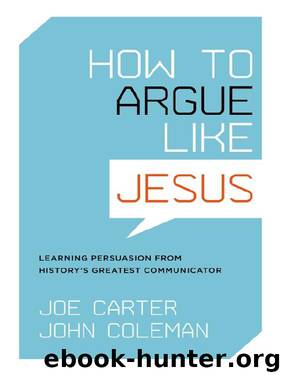How to Argue like Jesus: Learning Persuasion from History's Greatest Communicator by Joe Carter & John Coleman

Author:Joe Carter & John Coleman [Carter, Joe]
Language: eng
Format: epub
Tags: ebook, book
Publisher: Crossway
Published: 2008-12-18T08:00:00+00:00
IMAGERY: SIMILES AND METAPHORS
We are all familiar with the parables of Christ. But at the heart of Christ’s rhetoric is something even simpler than the parable or narrative—imagery. Through the use of descriptive language, similes, and metaphors, Christ condensed the power of the parable to two- and three-word descriptions that bring the Scriptures to life and, like enthymemes, excite our imaginations.
These uses of imagery give us a more vivid understanding of the concepts Christ discussed, but they also allow us to fill in the blanks with our own experiences and mental images, drawing us into the conversation. As C. H. Dodd notes in his Parables of the Kingdom, “At its simplest the parable is a metaphor or simile drawn from nature or common life, arresting the hearer by its vividness or strangeness, and leaving the mind in sufficient doubt about its precise application to tease it into active thought.”4
Christ rarely delivered straight lectures. He used imagery; and at the heart of his stories were a few techniques—primarily metaphor and simile—that enlivened his language, excited his listeners, and allowed generations of audiences to more closely connect with his teachings.
Simile
Imagine you are walking through a museum when you come to a room featuring a new exhibit. The name of the exhibit is “The Kingdom of God.”
The first room you enter has a dirt floor with a ceiling that rises up for thirty or forty feet. You notice a small placard on the ground, and it says, “A grain of mustard seed.” In front of the card, so small that you would have missed it, lies a small seed.
Directly behind the seed, though, a large tree rises up, as if planted in the museum’s floor. You realize that the chirping of birds is not canned noise but the songs of real birds who have made their home in that tree.
You ponder the meaning of the exhibit as you move to the adjacent rooms. Many of the rooms merely contain large screens on which strange films are being projected. In some a person discovers pearls in a marketplace or treasures in a field. Some of the films depict mundane jobs—a worker in a vineyard, a farmer sowing seeds, a fisherman casting a fishnet—while others are about a king, settling debts, and hosting wedding banquets.
As you leave the exhibit hall, pondering the meaning of these images, you stop before a sign that reads, “These things are what the Kingdom of heaven is like.”
Reading the Gospels provides a similar experience. Instead of finding sculptures, paintings, or films, we discover imagery that develops through similes—word pictures that create a comparison of two unlike things, usually using “like,” “as,” or “than.” Jesus often used similes, particularly when discussing the Kingdom of God. Consider the examples in which Jesus told us what the Kingdom of Heaven is like:
a mustard seed (Matthew 13:31–32; Mark 4:30–32; Luke 13:18–19)
yeast in bread (Matthew 13:33; Luke 13:20–21)
treasure hidden in a field (Matthew 13:44)
a merchant in search of fine pearls (Matthew 13:45–46)
a fishnet thrown into
Download
This site does not store any files on its server. We only index and link to content provided by other sites. Please contact the content providers to delete copyright contents if any and email us, we'll remove relevant links or contents immediately.
The Hatha Yoga Pradipika (Translated) by Svatmarama(2508)
Real Sex by Lauren F. Winner(2492)
The Holy Spirit by Billy Graham(2436)
The Secret Power of Speaking God's Word by Joyce Meyer(2264)
The Gnostic Gospels by Pagels Elaine(2041)
Devil, The by Almond Philip C(1910)
23:27 by H. L. Roberts(1897)
Jesus by Paul Johnson(1897)
The Nativity by Geza Vermes(1856)
All Things New by John Eldredge(1790)
Chosen by God by R. C. Sproul(1772)
Angels of God: The Bible, the Church and the Heavenly Hosts by Mike Aquilina(1633)
The Return of the Gods by Erich von Daniken(1580)
Angels by Billy Graham(1556)
Evidence of the Afterlife by Jeffrey Long(1464)
Knowing God by J.I. Packer(1437)
The Gnostic Gospel of St. Thomas by Tau Malachi(1417)
How To Be Born Again by Billy Graham(1411)
Victorian Sensation by James A. Secord(1410)
